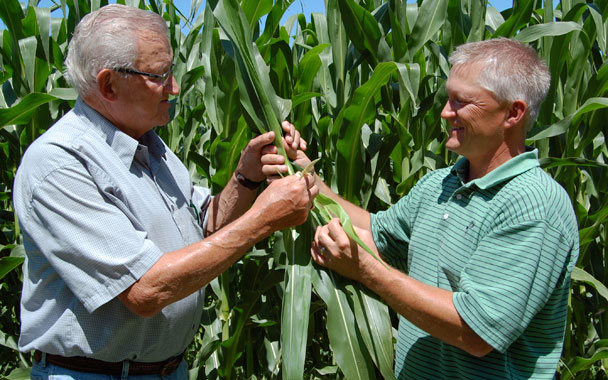Scott and Roger Christenson, Brown County, South Dakota
What a difference 50 miles make. Roger and Scott Christenson grow corn in the James River Valley, the northern edge of the South Dakota corn belt and snug against the North Dakota border. Their family farm, built over decades with their father, Rollin, is only 50 miles east of our first two farmers, Jim Lutter and Dale Hargens. Those farms are closer to the infamous “too dry to farm” western edge of American farming along the 100th meridian. But those few miles makes a world of difference out here, and that teaches an important lesson: All farming is local.
This is prairie pothole country. It was carved flat by ancient glaciers, and, in fact, the James River is the flattest river in the nation. Millions of ducks and geese breed in the shallow lakes each summer. Even when it rains 30 miles north, the local water table rises. While farmers to the west spend their July watching the horizon for fleeting hit-or-miss storms, the Christensons spend the month imagining the root systems of their corn reaching down to meet the water table.
The Christensons farm 5,000 acres. They planted 700 acres of soybeans this year. About 1,000 acres is dedicated to tree shelters, pasture, lakes, wetlands, and rivers. “We grow a lot of ducks,” Roger shrugs. But the heart of their operation is 3,200 acres of commodity corn. “Corn is King,” explains Rollin Christenson. “And these boys have been raised in the belief that corn is our livelihood.”
In mid-July, corn in the best Christenson fields is at least seven feet tall and ready to tassel, a solid two feet taller than corn on the Hargens and Lutter farms. Different soil, different seeds, different moisture. All farming is local.
The Christensons are industrial farmers and proud of it. “Farming is no longer just a romantic lifestyle,” says Rollin. “It’s a high-tech business.” They are outspoken advocates of ethanol, and sell much of their corn crop to the Poet Biorefinery, 30 miles down the road in Groton. I ask Scott if he has any concerns about growing food crops for fuel. “No. But I have a problem with people who have a problem with me growing corn for ethanol.” Rollin joins in. “Most people in the cities think that the corn goes into an ethanol plant and is used up. But making ethanol just takes out the alcohol. The byproduct is distillers’ dry grain, a high-protein cattle feed.” The way the Christensons see it, their corn creates fuel and still feeds people. They are well aware that some people think of large-scale industrial farming as the Darth Vader of the farm economy, but if the public is searching for a scapegoat, they suggest, it would be better to look at the power of big oil companies.
The foundation principle of the Christenson family is that they know what their land can do, and what it can’t. They don’t pretend that their methods would work in another ecosystem, and they shrug off suggestions that methods used by neighbors “across the fence line” would work for them. They plant genetically modified seeds, but they use many different varieties in many different fields, depending on soil conditions. This year, for the first time, the Christenson brothers used GPS readings and a grid of almost 400 soil samples to calculate the fertilizer needs of each individual field. High-tech machinery spread perfectly calculated amounts of fertilizer on each separate portion of every field. “We probably saved $60,000 in fertilizer costs,” Scott says. By applying only what is needed, only where it is needed, they also reduced the environmental impact of their fertilizer application.
The biggest worry the Christensons have right now is the instability of the global oil economy. The demand for petro-chemical fertilizer is so tight all across the farm belt that the Christensons and their neighbors are forced to purchase and store huge stockpiles of fertilizer for crops they won’t plant until 2009, or sell until 2010. “We’re going in blind,” Scott says. “We have to buy inputs for 2009. But in today’s market we can’t get a bid on 2009 crops and lock in contracts.” At the scale of the Christenson farm, they have to borrow hundreds of thousands of dollars to buy fertilizer that they can’t pay for until two to three years down the road, when the global economy might look very, very different.


